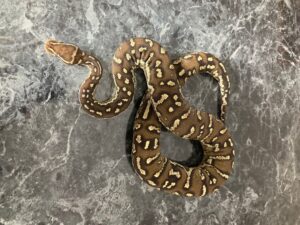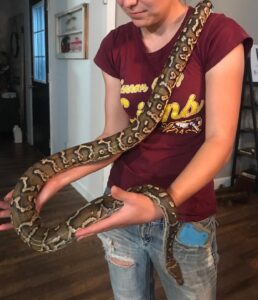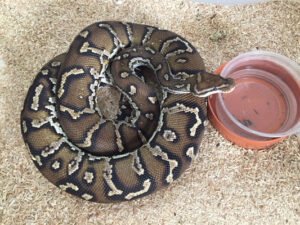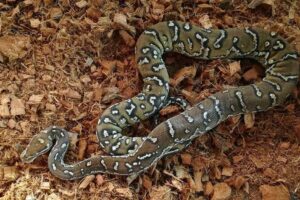The Angolan python is a species of python found in Southern Africa. It is non-venomous like all other pythons. Named after the Portuguese naturalist and explorer Jose Alberto de Oliveira Anchieta, the Angolan python is closely related to the ball python. It is one of the rarest snakes living in Africa today.
They are a nocturnal species that have developed several adaptations for nighttime foraging, such as large eyes, excessive pitting on the upper and lower labial scales, and heat-sensing pits.
Its easygoing nature and unique personality make it an excellent fit to be a pet. However, they are rarely found in captivity due to the long civil war in Angola. Though the war is over now, the forests and fields are covered with land mines, making catching these snakes quite risky. The few that are captured are highly valued and sought after.
Scientific Classifications
- Suborder:Serpentes
- Family:Pythonidae
- Genus:Python
- Species:P. anchietae
Conservation Status
Description
Size
These pythons can be as long as 72 inches (183 cm).
Color and Appearance
Angolan pythons have a body color ranging from reddish-brown to brown to the almost black ground color pattern, with white or cream-colored bands on top. They have yellow bellies.
These pythons have “bead-like” head scales and smooth dorsal scales arranged in 57 to 61 rows. The tails of the males are thicker than those of females.
Are They Dangerous to Humans
They are non-venomous and not dangerous to humans. They are constrictors who rarely bite.
Angolan Python at a Glance
Distribution
Angolan pythons live in northern Namibia and southern Angola in Africa. They occupy a larger part of Namibia than Angola.
Their habitat range is from Lobito in Angola down to Maltahohe in Namibia. In Angola, they are more common in Catumbella near Lobito, and in Namibia, they live in more inland areas towards Otavi.
Habitat
Their habitats are rocky outcrops or areas strewn with rocks in open grassland or brush, often taking shelter in small caves, crevices, and overhangs. They can live in rocky areas with elevations about 2460-5250 feet above sea level.
Angolan pythons can tolerate extreme temperatures as high as 122 °F and as low as 32°F. They can retain moisture through their bead-like scales, which enables them to live in dry environments.
Lifespan
Their lifespan is around 30 years or more in captivity under proper care.
Predators
Wild dogs, hyenas, large insects and frogs, spiders, birds, and other snakes eat these pythons.
Diet
Small mammals, amphibians, and birds form their regular diet, while they feed on insects occasionally.
They are ambush predators who wait for the prey to come near them, detecting a potential meal with the help of the five heat-sensing pits on each side of their heads. When it comes, they grab the prey, wrap tightly around it, squeeze and suffocate it using their powerful body muscles and swallow it whole.
Reproduction
Oviparous in nature, they lay small clutches of 4-5 eggs that hatch after 70 days. The hatchlings are 10-17 inches long and are independent from birth. They become sexually mature at the age of three.
Similar Species
Ball Python
Ball pythons and Angolan pythons resemble each other in terms of looks but not in terms of their behavior. Angolan pythons are friendlier, easier to handle, and more active than ball pythons.
Care Sheet
Size of Enclosure: They require an enclosure with a lot of space; the larger, the better. The adults can live in a terrarium of about 2 ft X 2 ft X 2 ft. The items kept inside the terrarium should be immovable to prevent the snake from destroying them.
Substrate: A simple substrate is required to recreate their natural habitat. Primary substrates like paper towels or newspapers or natural substrates like eco earth, cork bark, coco fiber, or aspen bedding are used in their terrarium.
Humidity: A humidity level of 50% should be maintained by keeping a water source in the enclosure. Unlike other pythons, the Angolan pythons seldom require misting.
Temperature: They require hot days and cold nights for thermoregulation. Their enclosure should have a hot spot (90⁰F) and a cold spot (75⁰F).
Lighting: Their natural habitat’s warm and dry climate should be recreated in their enclosure. The household lights work well for them without the need for extra lighting. However, the lights should be turned on in the daytime and switched off at night to maintain the day and night pattern.
Diet/Feeding: The favorite food of Angolan pythons is freshly killed or frozen, then thawed rats. They should be watched while eating to prevent injury if live prey is given.
Source
cloudfront.net, community.morphmarket.com, donvitobari.it, reptilehow.com









